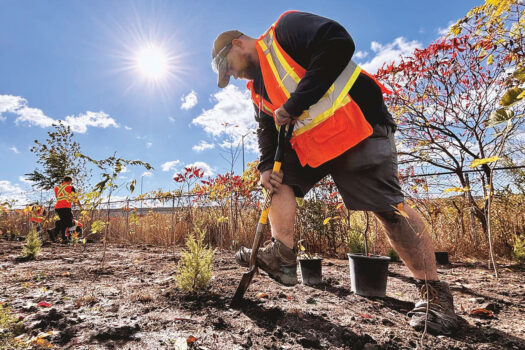By Jen Llewellyn
OMAFRA nursery crops specialist
Don’t be too surprised if we find some hot spots for white grub populations in 2009. The cool, rainy conditions we had during early grub development last summer should have helped improve the successful development of a good percentage of the grubs in the soil. We’ve had a few notable years for Japanese beetle now, especially in 2006 and 2007. Japanese beetle adult traps are very good at attracting the beetles, almost a little too good. In June, make sure you are placing Japanese beetle traps as far away as possible from your (and your neighbour’s) rosaceous plants (Rosa, Prunus, etc.). You should also be emptying traps one to two times a week to keep them open and ready to trap more adults.
Scale insects continue to plague established ornamentals in the landscape. Applications of the dormant rate of horticultural oil should be finishing up and the next opportunity to manage scale populations will be once the crawlers hatch. Horticultural oil can be an effective tool, but it takes some determination to get acceptable efficacy. Agitation, application to the undersides of twigs and foliage and repeated applications (7-10 days apart) should result in good suppression of insects and mites. The repeated applications are needed since scale insects emerge over a one to three week period and the oil must be applied to the emerged crawlers in order to smother them.
Viburnum leaf beetle has been a real challenge on several Viburnum species, often causing significant dieback and mortality in just two to three years of defoliation. Last spring, we conducted a small efficacy trial to test some of the softer insecticidal products that will be exempt from pesticide regulations. We found that repeated applications of the summer rate of horticultural oil gave some good suppression of newly hatched larvae. However, the oil can be phytotoxic to newly emerged foliage when temperatures soar, so be careful.
Gymnosporangium is the genus of fungus that is responsible for pear trellis rust, hawthorn rust and cedar-apple rust. Where pear trellis rust was a problem last year, monitor juniper hosts for Gymnosporangium rust sporulation (bright orange gelatinous masses, bright orange powdery masses) in May and early June. Gymnosporangium tends to sporulate on juniper hosts when the weather is warm and rainy. These spores will land on the alternate hosts: pear, apple, crabapple, hawthorn, etc., and cause unsightly orange lesions, followed by projectile fungal structures in late summer. You can prune out Gymnosporangium rust galls on Junipers to help minimize spore production this month. Nova fungicide is registered to help manage foliar diseases like Gymnosporangium rusts in nursery production.
Diseases and insect pests in May
Check out OMAFRA Publication 383, Nursery and Landscape Plant Production and IPM for more detailed monitoring tables (Chapter #3). To order, call 1-800-668-9938.
a) In areas where the following indicator plants (100-150 GDD Base 10oC): Aesculus hippocastanum (horsechestnut) are in full bloom. Syringa vulgaris (common lilac) are in full bloom. Spiraea x vanhouttei (bridalwreath spirea) are in full bloom
| PLANT | PEST |
| Betula | birch leafminer (larvae), bronze birch borer (adults) |
| Buxus | boxwood psyllid (nymphs) |
| Cornus, Fraxinus, Syringa | oystershell scale (crawlers) |
| Deciduous trees | gypsy moth (larvae), fall cankerworm (larvae) |
| Euonymus | euonymus webworm |
| Fraxinus | emerald ash borer (larvae, pupae, adults), ash plant bug |
| Malus, Prunus, Picea, Thuja Juniperus etc. | eastern tent caterpillar (larvae), spruce spider mite eggs, nymphs |
| Pinus | European pine sawfly (larvae), pine needle scale (crawlers), pine shoot beetle (larvae) |
| Rhododendron, Taxus, Euonymus and various | black vine weevil (larvae, pupae, adults) |
| Sorbus | mountain ash sawfly (larvae) |
| Syringa | lilac borer (eggs, larvae) |
| Taxus | Taxus mealybug (nymphs), Fletcher scale (nymphs) |
| Thuja | cedar leafminer (pupae, adults), strawberry root weevil (adults) |
| PLANT | DISEASE |
| Corylus | filbert blight |
| Malus, Pyrus | apple scab |
| Malus, Crataegus Amelanchier, Pyrus | Gymnosporangium rust (cedar-apple, cedar- hawthorn, pear trellis) |
b) In areas where the following phenology plants (150-250 GDD Base 10oC ): Aesculus hippocastanum (horse chestnut) are in full to late bloom. Spiraea x vanhouttei (bridalwreath spirea) are in late to finished bloom. Syringa vulgaris (common lilac) are in late to finished bloom. Robinia.pseudoacacia (black locust) are blooming
| PLANT | INSECT |
| Betula | birch leafminer (larvae), bronze birch borer (eggs, larvae), birch case bearer (larvae) |
| Deciduous trees | gypsy moth (larvae) |
| Euonymus, deciduous | euonymus webworm (larvae) |
| Fraxinus | emerald ash borer (adults, eggs, larvae) |
| Gleditsia | honeylocust plantbug (nymphs), honeylocust leafhopper (nymphs), honeylocust podgall midge (larvae) |
| Picea, Juniperus, Thuja, Abies | spruce spider mite (nymphs, adults) |
| Pinus | European pine sawfly (larvae), pine needle scale (nymphs) |
| Syringa | lilac borer (adults, eggs) |
| Syringa, Fraxinus,Cornus | oystershell scale (crawlers) |
| Taxus | Fletcher scale (adults, eggs), Taxus mealybug (nymphs) |
| Taxus, Rhododendron, Euonymus | black vine weevil (pupae, adults) |
| Thuja | cedar leaf miner (pupae, adults) |
| Ulmus | elm leaf beetle (larvae) |
| Viburnum | viburnum leaf beetle (larvae, pupae) |
| PLANT | DISEASE |
| 2-needled pines | Diplodia tip blight |
| Malus, Crataegus, Amelanchier, Pyrus | Gymnosporangium sp. |
| Malus | apple scab |
| Malus, Pyrus, Pyracantha, Cotoneaster | fire blight |
| Euonymus | anthracnose |
| Fraxinus, Tilia, Acer, Quercus, Platanus | anthracnose, Verticillium wilt |
| Prunus, Ribes Rosa, Amelanchier | powdery mildew |
Contact Jennifer Llewellyn at 519-824-4120, ext. 52671, Fax: 519-767-0755, or e-mail: jennifer.llewellyn@ontario.ca.






